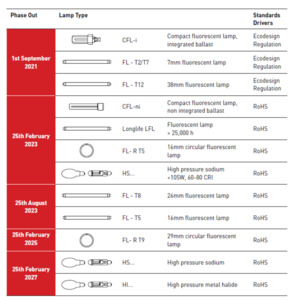

|
Edward Lowton
Editor |


|
| Home> | Energy Management | >Lighting | >Impact of the 2023 lamp ban |
Impact of the 2023 lamp ban
24 November 2022
WITH ENERGY costs soaring and the growing threat of dwindling lamp supplies, building operators risk compromising their warehouses' safety and productivity.

Against this backdrop, the impeding lamp ban opens opportunities to benefit from new lighting technologies. But how can you achieve this quickly if it is not budgeted?
The countdown is on. From February 2023, the RoHS Directive (EU) 011/65/EU and the Ecodesign Regulation (EU) 2019/2020 takes effect.
Lamps and luminaires containing mercury and/or do not meet minimum efficiency values can no longer be sold. Only remaining stocks can be used. It is time to say goodbye to the much-loved fluorescent lamp.
However, there are many benefits:
Global impact
The fluorescent lamp phase-out plays an integral role in the EU's commitment to cut emissions by 55% by 2030, aiming to become the first region to reach climate neutrality by 2050.
Banning mercury lamps equates to 1.8 tonnes less mercury from the lamps and a further 1.5 tonnes of mercury from coal-fired power plant emissions due to the 190 TWh of electricity savings.
There are cost savings too. DG Environment estimates that in Europe, there will be 18.2 billion Euros in net financial savings (including costs associated with lamps, luminaires and labour).
The lamp ban opens new energy and costs savings opportunities for warehouses, factories and distribution centres.
Get ahead of the technology change
Nowhere are the demands on business efficiency and safety higher than in the industrial sector. Why join the race to purchase declining stocks of fluorescent lamps? Instead, by switching to LED now, you can negate the risk of lamp failures, costly downtime, and uncompliant schemes with no backup supplies.
LED systems are the optimal solution for meeting the increased requirements regarding compliance and reducing the burden of rising energy costs. They also offer advantages in terms of lighting quality, service life, installation and operational safety.
Advantages of a LED lighting system
- Watch your operating costs reduce by up to 85% with LED and light management
- Networking via the cloud achieves greater energy efficiency, transparency and convenience
- Expand your network to include industrial relevant applications such as location-based services
- Longer service life with lower maintenance requirements
- Higher light quality improves well-being and safety
- A single source supplier offers full service and a comprehensive warranty which provides planning security
- Subsidised Government grants available to help with costs
Think you don't have the budget?
An LED refurbishment sounds costly. In reality, the cost of conversion is typically offset by savings in operating costs. Good to know, but where to find the capital investment? To help, many building operators are now turning to Light as a Service - effectively renting your new lighting system. Investment goes on operating expenses (OPEX) rather than capital expenses (CAPEX). The lighting equipment remains the responsibility of the manufacturer, who then handles maintenance and sustainable disposal at the end of life.
At Trilux, we will happily advise you on your LED refurbishment and develop the optimum solution with you. Our years of experience as an industrial lighting partner put us in the best position to guide you on a sustainable, holistic solution tailor-made to your facilities' needs.


















